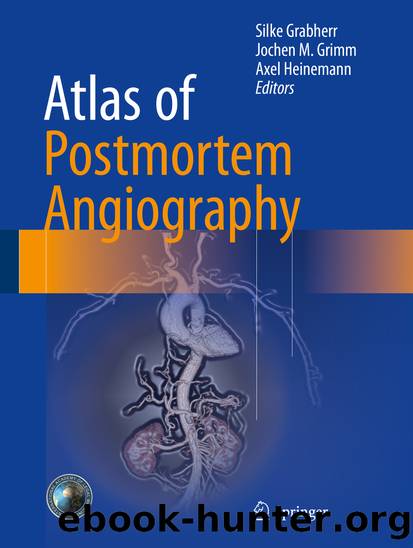Atlas of Postmortem Angiography by Silke Grabherr Jochen M. Grimm & Axel Heinemann

Author:Silke Grabherr, Jochen M. Grimm & Axel Heinemann
Language: eng
Format: epub
Publisher: Springer International Publishing, Cham
19.4 Iatrogenic Artefacts
19.4.1 Artefacts Resulting from Sample Collection
Before PMCTA and injection of contrast agent into the vascular system, different samples can and should be collected to allow for toxicologic, histologic, bacteriologic, and other specific analysis (see Chap. 30). The introduction of needles for collecting liquid samples or biopsies leaves visible traces that can be seen even by native CT or later by MPMTCA, which is very sensitive for detecting trajectories, even fine-needle ones. The sites of different samples depend, of course, on the local custom. Every center performing PMCTA should have a clearly defined protocol for indicating the sampling performed and the collection sites. It is useful to acquire views with the needle in place to compare them eventually to an artefact seen after angiography (Fig. 19.15). Using this kind of documentation should make it easy to recognize the artefacts and confirm their origins. If such images are not available, the native postmortem CT will possibly allow determination of whether an artefact was present prior to or only after the manipulation of the body (Figs. 19.16 and Fig. 19.17). For this reason, the native phase of MPMCTA should absolutely be performed before any invasive sampling on the body is done.
Some sample sites are difficult to access because of the location of the organ or the presence of large blood collections. The more difficult it is to reach the sample site, the higher the risk of inducing artefacts. For this reason, the sampling should be considered on a case-by-case basis together with the forensic pathologist in charge. In some cases, the collection of a cardiac blood sample can be indicated, but because this puncture is highly associated with artefacts and the radiologic reading can therefore be altered (Figs. 19.18 and Fig. 19.19), it seems difficult to justify performing this sampling in all cases of MPMCTA (see Chap. 30).
Fig. 19.15Iatrogenic artefacts. (a, c), Image obtained during the sampling procedure with the needle in position (white arrow). (a) Needle positioned in the gallbladder (yellow points) and the bladder (c). Such images should be part of the protocol of any intervention done on the body and can help to distinguish between an iatrogenic artefact and a real finding in cases of doubt. (b) Extravasations of contrast agent into the gallbladder (white arrow) due to the needle’s passage. (d) Needle trajectory in the subcutaneous fatty tissue caused by the needle’s passage (white arrow)
Download
This site does not store any files on its server. We only index and link to content provided by other sites. Please contact the content providers to delete copyright contents if any and email us, we'll remove relevant links or contents immediately.
| Administration & Medicine Economics | Allied Health Professions |
| Basic Sciences | Dentistry |
| History | Medical Informatics |
| Medicine | Nursing |
| Pharmacology | Psychology |
| Research | Veterinary Medicine |
Periodization Training for Sports by Tudor Bompa(7946)
Why We Sleep: Unlocking the Power of Sleep and Dreams by Matthew Walker(6386)
Paper Towns by Green John(4826)
The Immortal Life of Henrietta Lacks by Rebecca Skloot(4274)
The Sports Rules Book by Human Kinetics(4097)
Dynamic Alignment Through Imagery by Eric Franklin(3935)
ACSM's Complete Guide to Fitness & Health by ACSM(3834)
Kaplan MCAT Organic Chemistry Review: Created for MCAT 2015 (Kaplan Test Prep) by Kaplan(3815)
Introduction to Kinesiology by Shirl J. Hoffman(3634)
Livewired by David Eagleman(3547)
The River of Consciousness by Oliver Sacks(3431)
The Death of the Heart by Elizabeth Bowen(3355)
Alchemy and Alchemists by C. J. S. Thompson(3312)
Descartes' Error by Antonio Damasio(3170)
Bad Pharma by Ben Goldacre(3118)
The Gene: An Intimate History by Siddhartha Mukherjee(2942)
The Emperor of All Maladies: A Biography of Cancer by Siddhartha Mukherjee(2942)
The Fate of Rome: Climate, Disease, and the End of an Empire (The Princeton History of the Ancient World) by Kyle Harper(2893)
Kaplan MCAT Behavioral Sciences Review: Created for MCAT 2015 (Kaplan Test Prep) by Kaplan(2832)
